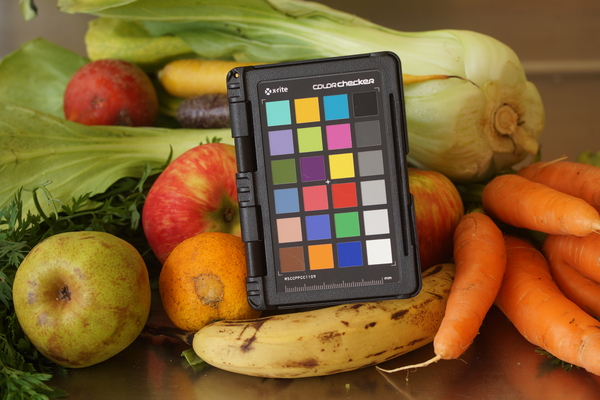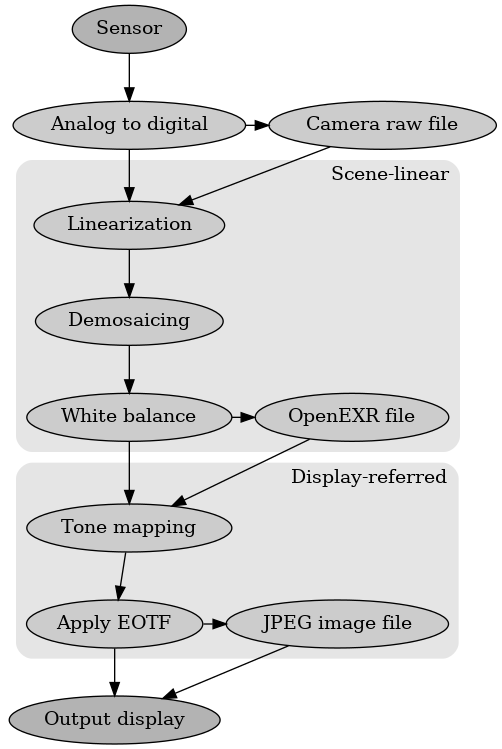Scene-Linear Image Representation¶
OpenEXR images are intended to store scene-referred linear data. “Scene-referred” means the pixel values indicate how much light was received by the camera. “Linear-light” means the numbers in the image are directly proportional to the amount of light they represent. Most image formats are display-referred, where the values indicate how much light should be used to display the image on a screen (or how much ink to use to print the image onto paper), and many image formats apply an encoding to the image so that the numbers are not linear. Some sources use the term “input-referred” and “output-referred” as alternatives to “scene-referred” and “display-referred” [1].
This is a brief description of the difference between scene-referred and display-referred representations, what linear-light means, and why using scene-referred images may be beneficial. For simplicity, the explanation here assumes the image is photographed by a digital camera and is displayed on a computer monitor. This discussion also applies to software generated images which are intended to appear to be digital photographs (photorealistic images): since that software works by mimicking the behavior of digital cameras, it should generate images that can be treated as if they were produced by a camera.
Note that although OpenEXR images were designed to store scene-referred color, this is not enforced by the library so OpenEXR images are not guaranteed to be scene-referred or to store linear-light values. There may be practical reasons to store image data in an OpenEXR file encoded with a different convention. OpenEXRs may also store data which is not RGB color, such as displacement maps or 3D point positions. When sharing OpenEXR images with others, it is important to clarify exactly how the data is represented in the file. This also means the default processing applied by a software package to an OpenEXR image may not be consistent with the way the data is stored.
Input vs Output: Tone Mapping and Creativity¶
Few monitors are capable of representing the real world accurately. Monitors are limited in their brightness and many don’t display very dark colors (they have a limited contrast ratio). Also, they cannot produce colors as vivid as those seen in the real world. A scene in a forest may have clouds which are 25,000 times brighter than the darkest shadows in the trees. A camera may be able to capture that contrast ratio, but monitors may only display a range of about 1000:1. To ensure that the image on the monitor shows detail in the clouds as well as the shadows, the contrast range of the image must be reduced, lifting the brightness of the shadows and darkening down the clouds. Similarly the colorfulness must be reduced to fit within the range of colors that typical displays have. Reducing the range of the image is often called tone mapping and reducing the colorfulness is often called gamut compression [2]
These concepts are not strictly artifacts of digital photography: film stock does exactly the same thing chemically. This is because film projectors also have limited dynamic range. The film process is designed to project (or print onto paper) an image of lower contrast than the lens captured, so that it can represent details in both bright and dark areas without needing as much contrast as is present in the original scene. With film, the contrast usually is very low in bright parts of the scene, slightly higher than the original in the middle range, and higher in the dark shadows. This allows detail in clouds, and a feeling of darkness in shadows. This also affects the colors, tending to reduce the colorfulness of bright areas, and increasing the colorfulness of dark ones.

Example of image displayed with no tone mapping: although most colors are displayed faithfully to the original, the image looks flat¶

The same image displayed with the camera’s default tone mapping to create a more pleasing image with darker shadows and more vivid colors¶
Such film-based images are so common that an image which has not had that process applied appears incorrect, so many digital tone mapping approaches are inspired by reproducing what film would do, to make the image appear more familiar and so more natural. The images above illustrate this. The first image is the Carrots.exr test image processed so the pixels have the same color and intensity that the real objects had [3]. This particular scene has low enough contrast and subtle enough colors that monitors are capable of displaying it faithfully. The second image is a JPEG created by the camera using its built-in tone mapping of the image. This image looks more pleasing, even though the colors are no longer faithful to those originally observed.
High Dynamic Range displays don’t need as much tone mapping, since they are capable of a contrast that is much closer to the original image, and LED and laser-based technology can display images which appear to be almost as colorful as the real world. However, the audience is so used to seeing film-like images with contrast adjustments applied that it is usual to apply a certain amount of tone mapping. Appendix 1 of BT.2100 discusses tone mapping in HDR images.
Images may also have a creative look applied. An artist may want the image to look different, perhaps dramatically darkening the clouds or lifting the brightness of the entire image so that the dark areas are light gray instead of black. They may remove the color completely and make the image black and white. This could be done manually with an image editing tool, or by choosing a predefined transform to modify the image.
Most digital images have already been tone mapped and processed for display. This means the images are display-referred: the numbers in the image represent how it should be displayed on a screen. By contrast, the OpenEXR format is designed to store scene-referred values, where the numbers represent the light captured by the camera. Scene-referred images have not (yet) been tone mapped ready for display.
Advantages of Scene-Referred Representation¶
Since scene-referred images represent what the camera saw, they are ideal for applying photo-real modifications. Scene-referred imagery can help when inserting a computer generated character into a photographed background, and make it appear as if the character was really there. We wish to make the combined image appear as if a camera really photographed it, so we need to compute what light would have been captured by the camera. This task is much easier if the photographed background is a scene-referred image, and the software that generates the character also stores a scene-referred image as seen by the “virtual camera” in the software. If both the photograph of the background and the computer generated image are display-referred, with some artistic look applied, it will be much harder to produce a convincing composite image. OpenEXR images are widely used for motion picture visual effects precisely for this reason, and they are increasingly used in photoreal computer games.
Scene-referred images are also helpful precisely because they have not yet been tone mapped. A processing task such as removing unwanted objects can be done using scene-referred images, because the object will need to be removed regardless of what further processing is applied. Decisions about artistic looks can be applied to the scene-referred images after the object is removed. Multiple tone-mappings can also be applied to the data to suit different display environments without the need to redo any work.
Disadvantages of Scene-Referred Representation¶
Many of the advantages of using OpenEXR images and working with scene-referred data come with an added cost: because the file stores more detail than other formats, it is larger on disk and slower to process than other formats. Also, because it is scene-referred, further processing is required to tone map the image before display. That requires extra computational overhead, and there is a potential confusion if different people are looking at the same image but processing it for display in different ways.
For certain tasks, such as editing or titling video, there may not be an advantage in using scene-referred images, and formats other than OpenEXR may be more appropriate.
Non-Linear Representation¶
OpenEXR images are also intended to be linear-light: the numbers in the image are directly proportional to the amount of light they represent. So, a pixel which stores a value of 1000 represents one thousand times more light than a pixel with a value 1. This makes computation much faster and more accurate. Generally, display-referred images do not store linear values. The eye is less sensitive to small changes in bright objects than to changes in dark ones. A change in image intensity between 0.1 and 0.2 nits on a display is far more noticeable to the human eye than a change between 75 and 80 nits even though it’s 50 times smaller. Display-referred image representations therefore concentrate precision in low values, sacrificing precision in high detail. This allows for images to be stored with less overall detail (fewer bits per pixel), but appear just as accurate, as a larger image stored in linear. This non-linearity is often called an Electro-Optical Transform Function (EOTF), since it maps between the values stored electronically in the file and those presented optically on the monitor [4].
To handle an image with an EOTF, it is important to understand what that function is. It is often necessary to undo the function before modifying values, then reapply the function, which causes a loss of precision. OpenEXR images use floating point linear values to represent pixel intensities. Floating point values also store small values with more absolute precision than large ones, but there is no need to undo a function before using the values.
High Dynamic Range¶
Display referred images are often scaled relative to a maximum value, used to represent 100% brightness on the display device. For 8 bit images, this is usually 255. Because OpenEXR images are scene-referred, and represent the amount of incoming light, there should be no such limit: the light could always have been a little brighter.
The convention for scene-referred linear-light images is that the number represents how much light the surface reflects. An 18% gray card reflects 18% of the incident light, so should be represented by 0.18 in the scene-referred image [5]. Typically, bright reflections on metal would have values in scene-referred linear around 10.0, and bright lights above 100.0.
In practice, OpenEXR does have a maximum value it can store (65,504.0 in “half float” mode, 340,282,346,638,528,859,811,704,183,484,516,925,440.0 in “full float” mode), but these values are rarely reached, because those values correspond to extremely bright lights. This means it is possible to double the brightness of an image, save and reload it, then make it darker again, without losing detail due to values being clipped.
Image Processing Flowgraph¶

A simplified overview of a typical image processing chain between a digital camera and a display. OpenEXR images are scene-referred and have had camera-specific processing applied to bring them to a normalized scene referred linear space. JPEG images are display-referred, and have had all steps applied, ready to display. Other images which are created through the color chain need subsequent steps applied before being displayed.¶
Color Management Resources¶
OpenColorIO (OCIO) is a framework providing software libraries to apply color transformations based on a configuration. Since the same config is shared by all OCIO-compatible software, color conversions can be applied consistently when working with the same images in multiple software packages.
The Academy Color Encoding System (ACES) defines standard workflows to convert from raw camera images to scene-linear images, and a standard tone mapping system to convert to display-referred images. OpenColorIO configs are available which implement the necessary conversions. ACES image files (specified by SMPTE ST2065-4) are scene-linear OpenEXR images.
OpenImageIO provides a library and command line tools for loading and saving images in multiple formats, including OpenEXR, and supports image processing with OpenColorIO.
Footnotes
